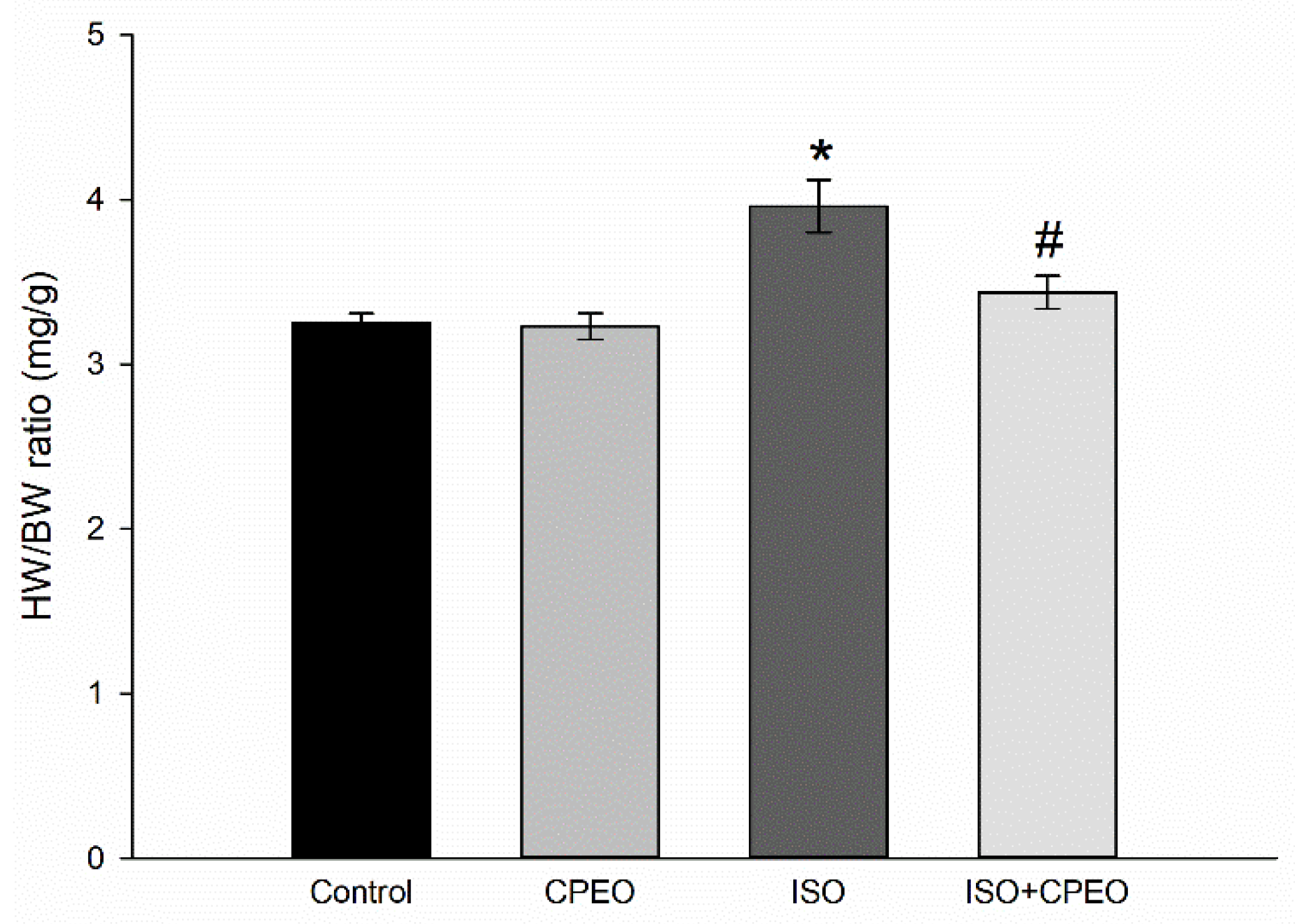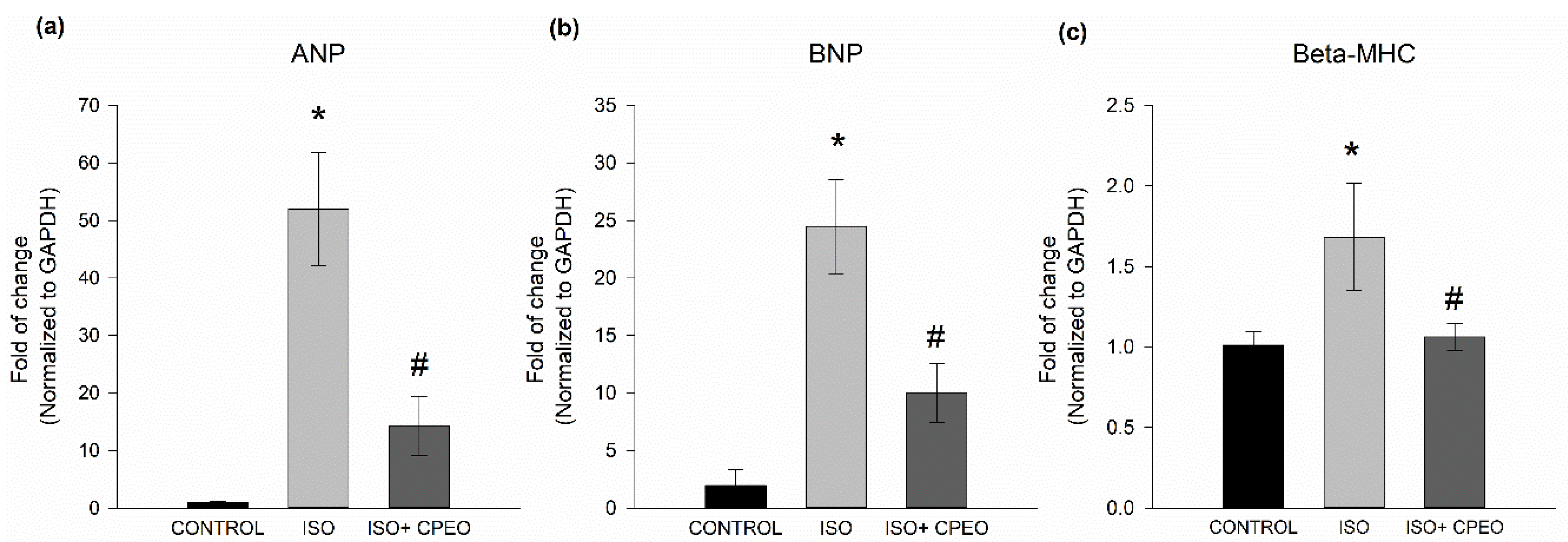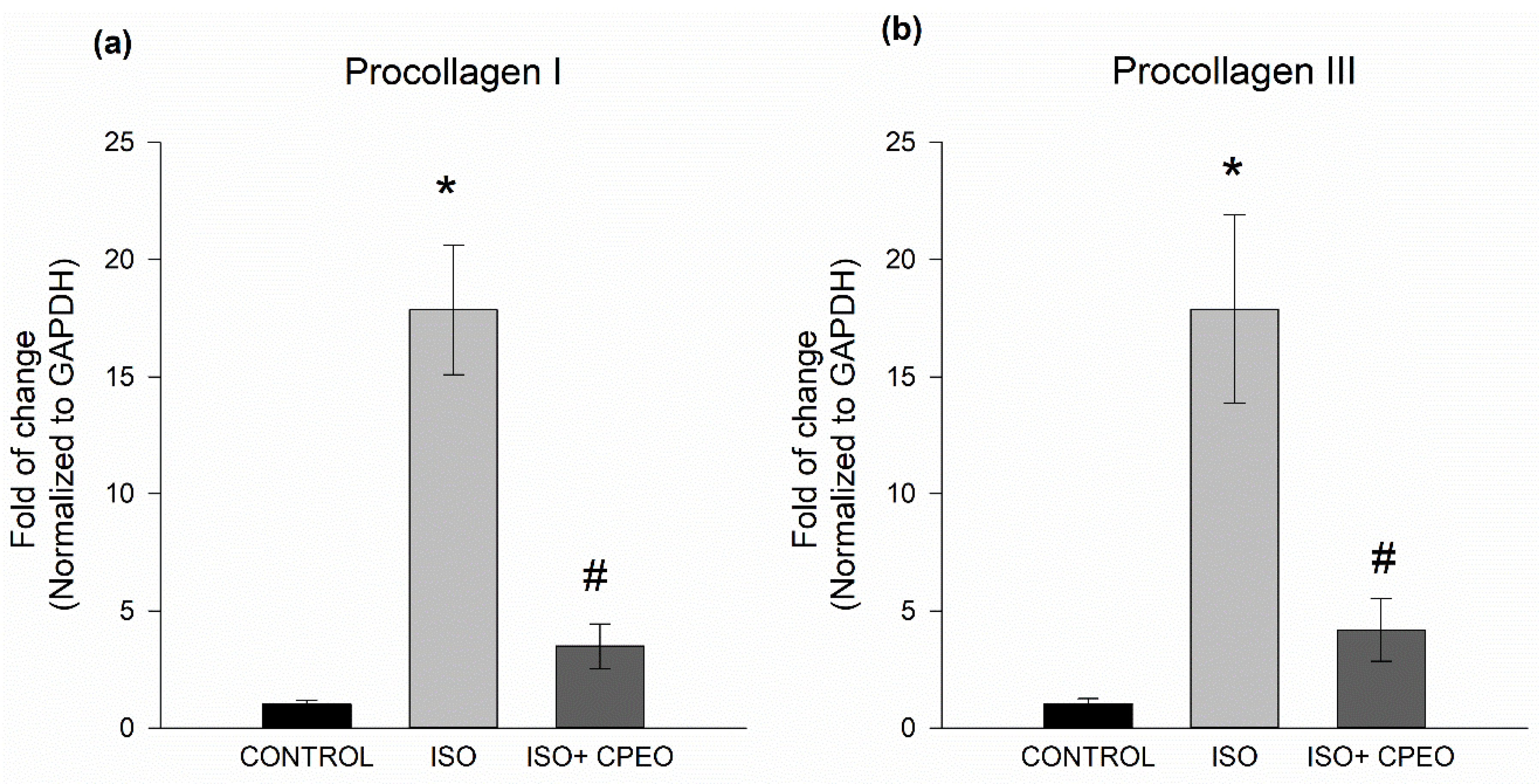Cymbopogon Proximus Essential Oil Protects Rats against Isoproterenol-Induced Cardiac Hypertrophy and Fibrosis
Abstract
1. Introduction
2. Results
2.1. Gas Chromatography–Mass Spectrometry (GC-MS) Analysis
2.2. Effect of C. Proximus Oil and/or Isoproterenol on Body and Heart Weights
2.3. Effect of C. Proximus Oil and/or Isoproterenol on Hypertrophy Markers
2.4. Effect of C. Proximus Oil and/or Isoproterenol on Myocardial Architecture
2.5. Effect of C. Proximus Oil and/or Isoproterenol on Myocardial Fibrosis
2.6. Effect of C. Proximus Oil and/or Isoproterenol on the Level of Fibrosis Markers
3. Discussion
4. Materials and Methods
4.1. Chemicals and Reagents
4.2. Plant Material
4.3. Preparation of C. Proximus Oil
4.4. GC/MS Analysis
4.5. Gas Chromatography (GC) Analysis
4.6. Animals
4.7. Experimental Design and Treatment Protocol
4.8. Histological Examination
4.9. RNA Extraction and Complementary DNA (cDNA) Synthesis
4.10. Quantification of mRNA Expression by Quantitative Real-Time PCR
4.11. Statistical Analysis
5. Conclusions
Author Contributions
Funding
Acknowledgments
Conflicts of Interest
References
- Benjamin, E.J.; Muntner, P.; Alonso, A.; Bittencourt, M.S.; Callaway, C.W.; Carson, A.P.; Chamberlain, A.M.; Chang, A.R.; Cheng, S.; Das, S.R.; et al. Heart Disease and Stroke Statistics-2019 Update: A Report From the American Heart Association. Circulation 2019, 139, e56–e528. [Google Scholar] [CrossRef] [PubMed]
- World Health Organization Cardiovascular Diseases (CVDs). 2017. Available online: https://www.who.int/news-room/fact-sheets/detail/cardiovascular-diseases-(cvds) (accessed on 1 March 2020).
- Dzau, V.; Braunwald, E. Resolved and unresolved issues in the prevention and treatment of coronary artery disease: A workshop consensus statement. Am. Heart J. 1991, 121, 1244–1263. [Google Scholar] [CrossRef]
- Dzau, V.J.; Antman, E.M.; Black, H.R.; Hayes, D.L.; Manson, J.E.; Plutzky, J.; Popma, J.J.; Stevenson, W. The cardiovascular disease continuum validated: Clinical evidence of improved patient outcomes: Part I: Pathophysiology and clinical trial evidence (risk factors through stable coronary artery disease). Circulation 2006, 114, 2850–2870. [Google Scholar] [CrossRef]
- Savarese, G.; Lund, L.H. Global public health burden of heart failure. Card. Fail. Rev. 2017, 3, 7–11. [Google Scholar] [CrossRef]
- Jones, N.R.; Hobbs, F.R.; Taylor, C.J. Prognosis following a diagnosis of heart failure and the role of primary care: A review of the literature. BJGP open 2017, 1, bjgpopen17X101013. [Google Scholar] [CrossRef]
- Chrysant, S.G. A new paradigm in the treatment of the cardiovascular disease continuum: Focus on prevention. Hippokratia 2011, 15, 7–11. [Google Scholar]
- Althurwi, H.N.; Maayah, Z.H.; Elshenawy, O.H.; El-Kadi, A.O.S. Early changes in cytochrome P450s and their associated arachidonic acid metabolites play a crucial role in the initiation of cardiac hypertrophy induced by isoproterenol. Drug Metab. Dispos. 2015, 43, 1254–1266. [Google Scholar] [CrossRef] [PubMed]
- Lüscher, T.F. Predictors as well as surrogate and hard endpoints in cardiovascular disease. Eur. Heart J. 2015, 36, 2197–2199. [Google Scholar] [CrossRef] [PubMed]
- Avoseh, O.; Oyedeji, O.; Rungqu, P.; Nkeh-Chungag, B.; Oyedeji, A. Cymbopogon species; ethnopharmacology, phytochemistry and the pharmacological importance. Molecules 2015, 20, 7438–7453. [Google Scholar] [CrossRef]
- Dutta, S.; Munda, S.; Lal, M.; Bhattacharyya, P.R. A short review on chemical composition therapeutic use and enzyme inhibition activities of Cymbopogon species. Indian J. Sci. Technol. 2016, 9, 1–9. [Google Scholar] [CrossRef]
- Ganjewala, D. Cymbopogon essential oils: Chemical compositions and bioactivities. Int. J. Essent. Oil Ther. 2009, 3, 56–65. [Google Scholar]
- Miguel, M.G. Antioxidant and anti-inflammatory activities of essential oils: A short review. Molecules 2010, 15, 9252–9287. [Google Scholar] [CrossRef]
- Ekpenyong, C. Cymbopogon Citratus stapf (DC) extract ameliorates atherogenic cardiovascular risk in Diabetes-induced Dyslipidemia in rats. Br. J. Med. Med. Res. 2014, 4, 4695–4709. [Google Scholar] [CrossRef]
- Mansour, H.A.; Newairy, A.S.A.; Yousef, M.I.; Sheweita, S.A. Biochemical study on the effects of some Egyptian herbs in alloxan-induced diabetic rats. Toxicology 2002, 170, 221–228. [Google Scholar] [CrossRef]
- Adeneye, A.A.; Agbaje, E.O. Hypoglycemic and hypolipidemic effects of fresh leaf aqueous extract of Cymbopogon citratus Stapf. in rats. J. Ethnopharmacol. 2007, 112, 440–444. [Google Scholar] [CrossRef] [PubMed]
- Campos, J.; Schmeda-Hirschmann, G.; Leiva, E.; Guzmán, L.; Orrego, R.; Fernández, P.; González, M.; Radojkovic, C.; Zuñiga, F.A.; Lamperti, L.; et al. Lemon grass (Cymbopogon citratus (D.C) Stapf) polyphenols protect human umbilical vein endothelial cell (HUVECs) from oxidative damage induced by high glucose, hydrogen peroxide and oxidised low-density lipoprotein. Food Chem. 2014, 151, 175–181. [Google Scholar] [CrossRef]
- Khan, S.J.; Afroz, S.; Khan, R.A. Antihyperlipidemic and anti-hyperglycemic effects of Cymbopogon jwarancusa in high-fat high-sugar Diet model. Pak. J. Pharm. Sci. 2018, 31, 1341–1345. [Google Scholar]
- El-Askary, H.; Meselhy, M.; Galal, A. Sesquiterpenes from Cymbopogon proximus. Molecules 2003, 8, 670–677. [Google Scholar] [CrossRef]
- Ibrahim, F.Y.; El-Khateeb, A.Y. Effect of herbal beverages of Foeniculum vulgare and Cymbopogon proximus on inhibition of calcium oxalate renal crystals formation in rats. Ann. Agric. Sci. 2013, 58, 221–229. [Google Scholar] [CrossRef]
- Selim, S.A. Chemical composition, antioxidant and antimicrobial activity of the essential oil and methanol extract of the Egyptian lemongrass Cymbopogon proximus Stapf. Grasas y Aceites 2011, 62, 55–61. [Google Scholar] [CrossRef]
- Warrag, N.M.; Tag Eldin, I.M.; Ahmed, E.M. Effect of Cymbopogon proximus (Mahareb) on ethylene glycol-induced nephrolithiasis in rats. African J. Pharm. Pharmacol. 2014, 8, 443–450. [Google Scholar]
- El-Nezhawy, A.O.H.; Maghrabi, I.A.; Mohamed, K.M.; Omar, H.A. Cymbopogon proximus extract decreases L-NAME-induced hypertension in rats. Int. J. Pharm. Sci. Rev. Res. 2014, 27, 66–69. [Google Scholar]
- El Tahir, K.; Abdel-Kader, M. Chemical and pharmacological study of Cymbopogon proximus volatile oil. Res. J. Med. Plant 2008, 2, 53–60. [Google Scholar]
- Kuwahara, K.; Nishikimi, T.; Nakao, K. Transcriptional regulation of the fetal cardiac gene program. J. Pharmacol. Sci. 2012, 119, 198–203. [Google Scholar] [CrossRef] [PubMed]
- Rajabi, M.; Kassiotis, C.; Razeghi, P.; Taegtmeyer, H. Return to the fetal gene program protects the stressed heart: A strong hypothesis. Heart Fail. Rev. 2007, 12, 331–343. [Google Scholar] [CrossRef] [PubMed]
- Iemitsu, M.; Miyauchi, T.; Maeda, S.; Sakai, S.; Kobayashi, T.; Fujii, N.; Miyazaki, H.; Matsuda, M.; Yamaguchi, I. Physiological and pathological cardiac hypertrophy induce different molecular phenotypes in the rat. Am. J. Physiol. Regul. Integr. Comp. Physiol. 2001, 281, R2029–R2036. [Google Scholar] [CrossRef]
- Machaj, F.; Dembowska, E.; Rosik, J.; Szostak, B.; Mazurek-Mochol, M.; Pawlik, A. New therapies for the treatment of heart failure: A summary of recent accomplishments. Ther. Clin. Risk Manag. 2019, 15, 147–155. [Google Scholar] [CrossRef]
- Chapman, B.; DeVore, A.D.; Mentz, R.J.; Metra, M. Clinical profiles in acute heart failure: An urgent need for a new approach. ESC Hear. Fail. 2019, 6, 464–474. [Google Scholar] [CrossRef]
- Koo, Y.E.; Song, J.; Bae, S. Use of plant and herb derived medicine for therapeutic usage in cardiology. Medicines 2018, 5, 38. [Google Scholar] [CrossRef]
- Pan, S.Y.; Zhou, S.F.; Gao, S.H.; Yu, Z.L.; Zhang, S.F.; Tang, M.K.; Sun, J.N.; Ma, D.L.; Han, Y.F.; Fong, W.F.; et al. New perspectives on how to discover drugs from herbal medicines: CAM’S outstanding contribution to modern therapeutics. Evidence-Based Complement. Altern. Med. 2013, 2013, 627375. [Google Scholar] [CrossRef]
- Nichtova, Z.; Novotova, M.; Kralova, E.; Stankovicova, T. Morphological and functional characteristics of models of experimental myocardial injury induced by isoproterenol. Gen. Physiol. Biophys. 2012, 31, 141–151. [Google Scholar] [CrossRef] [PubMed]
- Leenen, F.H.; White, R.; Yuan, B. Isoproterenol-induced cardiac hypertrophy: Role of circulatory versus cardiac renin-angiotensin system. Am. J. Physiol. Heart Circ. Physiol. 2001, 281, H2410–H2416. [Google Scholar] [CrossRef] [PubMed]
- Ryu, Y.; Jin, L.; Kee, H.J.; Piao, Z.H.; Cho, J.Y.; Kim, G.R.; Choi, S.Y.; Lin, M.Q.; Jeong, M.H. Gallic acid prevents isoproterenol-induced cardiac hypertrophy and fibrosis through regulation of JNK2 signaling and Smad3 binding activity. Sci. Rep. 2016, 6, 34790. [Google Scholar] [CrossRef] [PubMed]
- Gayathri, K.; Jayachandran, K.S.; Vasanthi, H.R.; Rajamanickam, G.V. Cardioprotective effect of lemon grass as evidenced by biochemical and histopathological changes in experimentally induced cardiotoxicity. Hum. Exp. Toxicol. 2011, 30, 1073–1082. [Google Scholar] [CrossRef]
- De Menezes, I.A.C.; Moreira, Í.J.A.; De Paula, J.W.A.; Blank, A.F.; Antoniolli, A.R.; Quintans-Júnior, L.J.; Santos, M.R.V. Cardiovascular effects induced by Cymbopogon winterianus essential oil in rats: Involvement of calcium channels and vagal pathway. J. Pharm. Pharmacol. 2010, 62, 215–221. [Google Scholar] [CrossRef]
- Gazola, R.; MacHado, D.; Ruggiero, C.; Singi, G.; MacEdo Alexandre, M. Lippia alba, Melissa officinalis and Cymbopogon citratus: Effects of the aqueous extracts on the isolated hearts of rats. Pharmacol. Res. 2004, 50, 477–480. [Google Scholar] [CrossRef]
- Simic, A.; Rančic, A.; Sokovic, M.D.; Ristic, M.; Vukojevic, J.; Marin, P.D.; Rančic, A.; Sokovic, M.D.; Ristic, M.; Simic, A.; et al. Essential Oil Composition of Cymbopogon winterianus. and Carum carvi. and Their Antimicrobial Activities Essential Oil Composition of Cymbopogon winterianus and Carum carvi and Their Antimicrobial Activities. Pharm. Biol. 2008, 46, 437–441. [Google Scholar] [CrossRef]
- Gbenou, J.D.; Ahounou, J.F.; Akakpo, H.B.; Laleye, A.; Yayi, E.; Gbaguidi, F.; Baba-Moussa, L.; Darboux, R.; Dansou, P.; Moudachirou, M.; et al. Phytochemical composition of Cymbopogon citratus and Eucalyptus citriodora essential oils and their anti-inflammatory and analgesic properties on Wistar rats. Mol. Biol. Rep. 2013, 40, 1127–1134. [Google Scholar] [CrossRef]
- Moreira, F.V.; Bastos, J.F.A.; Blank, A.F.; Alves, P.B.; Santos, M.R.V. Composição química e efeitos cardiovasculares do óleo essencial de Cymbopogon citratus DC. Stapf, Poaceae, em ratos. Brazilian J. Pharmacogn. 2010, 20, 904–909. [Google Scholar] [CrossRef]
- Schirone, L.; Forte, M.; Palmerio, S.; Yee, D.; Nocella, C.; Angelini, F.; Pagano, F.; Schiavon, S.; Bordin, A.; Carrizzo, A.; et al. A Review of the molecular mechanisms underlying the development and progression of cardiac remodeling. Oxid. Med. Cell. Longev. 2017, 2017, 1–16. [Google Scholar] [CrossRef] [PubMed]
- Kehat, I.; Molkentin, J.D. Molecular pathways underlying cardiac remodeling during pathophysiological stimulation. Circulation 2010, 122, 2727–2735. [Google Scholar] [CrossRef]
- Fizur, M.; Meeran, N.; Jagadeesh, G.S.; Selvaraj, P. Thymol attenuates altered lipid metabolism in β -adrenergic agonist induced myocardial infarcted rats by inhibiting tachycardia, altered electrocardiogram, apoptosis and cardiac hypertrophy. J. Funct. Foods 2015, 14, 51–62. [Google Scholar]
- Kwon, H., II; Jeong, N.H.; Kim, S.Y.; Kim, M.H.; Son, J.H.; Jun, S.H.; Kim, S.; Jeon, H.; Kang, S.C.; Kim, S.H.; et al. Inhibitory effects of thymol on the cytotoxicity and inflammatory responses induced by Staphylococcus aureus extracellular vesicles in cultured keratinocytes. Microb. Pathog. 2019, 134, 103603. [Google Scholar] [CrossRef] [PubMed]
- Al-Taee, H.; Azimullah, S.; Meeran, M.F.N.; Alaraj Almheiri, M.K.; Al Jasmi, R.A.; Tariq, S.; Ab Khan, M.; Adeghate, E.; Ojha, S. β-caryophyllene, a dietary phytocannabinoid attenuates oxidative stress, inflammation, apoptosis and prevents structural alterations of the myocardium against doxorubicin-induced acute cardiotoxicity in rats: An in vitro and in vivo study. Eur. J. Pharmacol. 2019, 858, 172467. [Google Scholar] [CrossRef] [PubMed]
- Chamanara, M.; Abdollahi, A.; Rezayat, S.M.; Ghazi-Khansari, M.; Dehpour, A.; Nassireslami, E.; Rashidian, A. Thymol reduces acetic acid-induced inflammatory response through inhibition of NF-kB signaling pathway in rat colon tissue. Inflammopharmacology 2019, 27, 1275–1283. [Google Scholar] [CrossRef]
- de Christo Scherer, M.M.; Marques, F.M.; Figueira, M.M.; Peisino, M.C.O.; Schmitt, E.F.P.; Kondratyuk, T.P.; Endringer, D.C.; Scherer, R.; Fronza, M. Wound healing activity of terpinolene and α-phellandrene by attenuating inflammation and oxidative stress in vitro. J. Tissue Viability 2019, 28, 94–99. [Google Scholar] [CrossRef]
- Meng, X.; Li, N.; Zhang, Y.; Fan, D.; Yang, C.; Li, H.; Guo, D.; Pan, S. Beneficial effect of β-elemene alone and in combination with hyperbaric oxygen in traumatic brain injury by inflammatory pathway. Transl. Neurosci. 2018, 9, 33–37. [Google Scholar] [CrossRef]
- Yang, H.; Jung, E.-M.; Ahn, C.; Lee, G.-S.; Lee, S.-Y.; Kim, S.-H.; Choi, I.-G.; Park, M.-J.; Lee, S.-S.; Choi, D.-H.; et al. Elemol from Chamaecyparis obtusa ameliorates 2,4-dinitrochlorobenzene-induced atopic dermatitis. Int. J. Mol. Med. 2015, 36, 463–472. [Google Scholar] [CrossRef]
- Nagoor Meeran, M.F.; Javed, H.; Al Taee, H.; Azimullah, S.; Ojha, S.K. Pharmacological properties and molecular mechanisms of thymol: Prospects for its therapeutic potential and pharmaceutical development. Front. Pharmacol. 2017, 8, 380. [Google Scholar] [CrossRef]
- Li, X.; Lin, Z.; Zhang, B.; Guo, L.; Liu, S.; Li, H.; Zhang, J.; Ye, Q. β-elemene sensitizes hepatocellular carcinoma cells to oxaliplatin by preventing oxaliplatin-induced degradation of copper transporter 1. Sci. Rep. 2016, 6, 21010. [Google Scholar] [CrossRef]
- Kim, C.; Cho, S.K.; Kim, K.-D.; Nam, D.; Chung, W.-S.; Jang, H.-J.; Lee, S.-G.; Shim, B.S.; Sethi, G.; Ahn, K.S. β-Caryophyllene oxide potentiates TNFα-induced apoptosis and inhibits invasion through down-modulation of NF-κB-regulated gene products. Apoptosis 2014, 19, 708–718. [Google Scholar] [CrossRef] [PubMed]
- Cho, J.Y.; Kim, H.Y.; Kim, S.-K.; Park, J.H.Y.; Lee, H.J.; Chun, H.S. β-Caryophyllene attenuates dextran sulfate sodium-induced colitis in mice via modulation of gene expression associated mainly with colon inflammation. Toxicol. Rep. 2015, 2, 1039–1045. [Google Scholar] [CrossRef] [PubMed]
- Ben Sghaier, M.; Mousslim, M.; Pagano, A.; Ammari, Y.; Luis, J.; Kovacic, H. β-eudesmol, a sesquiterpene from Teucrium ramosissimum, inhibits superoxide production, proliferation, adhesion and migration of human tumor cell. Environ. Toxicol. Pharmacol. 2016, 46, 227–233. [Google Scholar] [CrossRef]
- Nishiyama, T.; Masuda, Y.; Izawa, T.; Ohnuma, T.; Ogura, K.; Hiratsuka, A. Magnolol protects PC12 cells from hydrogen peroxide or 6-hydroxydopamine induced cytotoxicity. J. Toxicol. Sci. 2019, 44, 753–758. [Google Scholar] [CrossRef]
- Meyer-warnod, B. Natural Essential Oils: Extraction processes and applications to some major Oils. Perfum. Flavorist 1984, 9, 93–103. [Google Scholar]
- McLafferty, F.W.; Stauffer, D.B. The Wiley/NBS Registry of Mass Spectral Data; Wiley: New York, NY, USA, 1989. [Google Scholar]
- Zaghloul, A.M.; Abd El-Fattah, H.; Halim, A.F. Chemical investigation of the aerial parts of Anthemis melampodina. J. Pharm. Sci. 1989, 5, 23–33. [Google Scholar]
- Livak, K.J.; Schmittgen, T.D. Analysis of relative gene expression data using real-time quantitative PCR and the 2(-Delta Delta C(T)) Method. Methods 2001, 25, 402–408. [Google Scholar] [CrossRef]
Sample Availability: Samples of the C. proximus oil are available from the authors. |





| No. | Component Name | Yield % 1 |
|---|---|---|
| 1 | Elemol | 23.54 |
| 2 | Piperitone | 19.86 |
| 3 | β-Eudesmol | 11.35 |
| 4 | α-Eudesmol | 7.63 |
| 5 | β-Elemene | 4.61 |
| 6 | τ-Cadinol | 3.87 |
| 7 | Terpinolene | 3.48 |
| 8 | β-Selinenol | 2.55 |
| 9 | 3-Cyclohexen-1-one, 2-isopropyl-5-methyl | 2.44 |
| 10 | 4-Carene | 1.66 |
| 11 | Shyobunol | 1.46 |
| 12 | α-Terpineol | 1.21 |
| 13 | Cadina-1(10),4-diene | 1.13 |
| 14 | (−)-Guaia-6,9-diene | 0.75 |
| 15 | Limonene | 0.66 |
| 16 | Terpinolene | 0.56 |
| 17 | β-Caryophyllane, 4,8-epoxy | 0.52 |
| 18 | cis-Calamenene | 0.51 |
| 19 | trans-Geranylgeraniol | 0.49 |
| 20 | Epi-Cubenol | 0.49 |
| 21 | Espatulenol | 0.49 |
| 22 | 2-Carene | 0.44 |
| 23 | Cuparene | 0.38 |
| 24 | Thymol | 0.30 |
| 25 | (Z)-β-ocimene | 0.29 |
| 26 | Ermacrene B | 0.26 |
| 27 | α-Dihydroagarofuran | 0.26 |
| 28 | γ-Muurolene | 0.26 |
| 29 | Caryophyllene oxide | 0.24 |
| 30 | Shyobunol | 0.23 |
| 31 | α-Selinene | 0.20 |
| 32 | Espatulenol | 0.19 |
| 33 | p-Mentha-1,5-dien-8-ol | 0.15 |
| 34 | Anethole | 0.14 |
| 35 | Cadinene | 0.13 |
| 36 | Aromandendrene | 0.12 |
| 37 | δ-Elemene | 0.12 |
| 38 | Isocaryophyllene | 0.12 |
| 39 | Allo-Ocimene | 0.11 |
| 40 | α-Amorphene | 0.11 |
| Total | 93.27 |
| Gene | Forward Primer (5′–3′) | Reverse Primer (5′–3′) |
|---|---|---|
| ANP a | GCTTCGGGGGTAGGATTGACA | GGCAATGCGACCAAGCTGT |
| BNP b | TTTCCTTAATCTGTCGCCGCT | CTAAAACAACCTCAGCCCGTCA |
| β-MHC c | GCCGAGTCCCAGGTCAACAA | GTAATTCGAGGGCAGGAACCC |
| Pro I d | CGGCTCCTGCTCCTCTTAGG | CACTCGCCCTCCCGTTTTTG |
| Pro III e | TGGGATGCAACTACCTTGGT | AGGTGTAGAAGGCTGTGGAC |
| GAPDH f | CAGTGCCAGCCTCGTCTCAT | CAAGAGAAGGCAGCCCTGGT |
© 2020 by the authors. Licensee MDPI, Basel, Switzerland. This article is an open access article distributed under the terms and conditions of the Creative Commons Attribution (CC BY) license (http://creativecommons.org/licenses/by/4.0/).
Share and Cite
Althurwi, H.N.; Abdel-Kader, M.S.; Alharthy, K.M.; Salkini, M.A.; Albaqami, F.F. Cymbopogon Proximus Essential Oil Protects Rats against Isoproterenol-Induced Cardiac Hypertrophy and Fibrosis. Molecules 2020, 25, 1786. https://doi.org/10.3390/molecules25081786
Althurwi HN, Abdel-Kader MS, Alharthy KM, Salkini MA, Albaqami FF. Cymbopogon Proximus Essential Oil Protects Rats against Isoproterenol-Induced Cardiac Hypertrophy and Fibrosis. Molecules. 2020; 25(8):1786. https://doi.org/10.3390/molecules25081786
Chicago/Turabian StyleAlthurwi, Hassan N., Maged S. Abdel-Kader, Khalid M. Alharthy, Mohamad Ayman Salkini, and Faisal F. Albaqami. 2020. "Cymbopogon Proximus Essential Oil Protects Rats against Isoproterenol-Induced Cardiac Hypertrophy and Fibrosis" Molecules 25, no. 8: 1786. https://doi.org/10.3390/molecules25081786
APA StyleAlthurwi, H. N., Abdel-Kader, M. S., Alharthy, K. M., Salkini, M. A., & Albaqami, F. F. (2020). Cymbopogon Proximus Essential Oil Protects Rats against Isoproterenol-Induced Cardiac Hypertrophy and Fibrosis. Molecules, 25(8), 1786. https://doi.org/10.3390/molecules25081786





